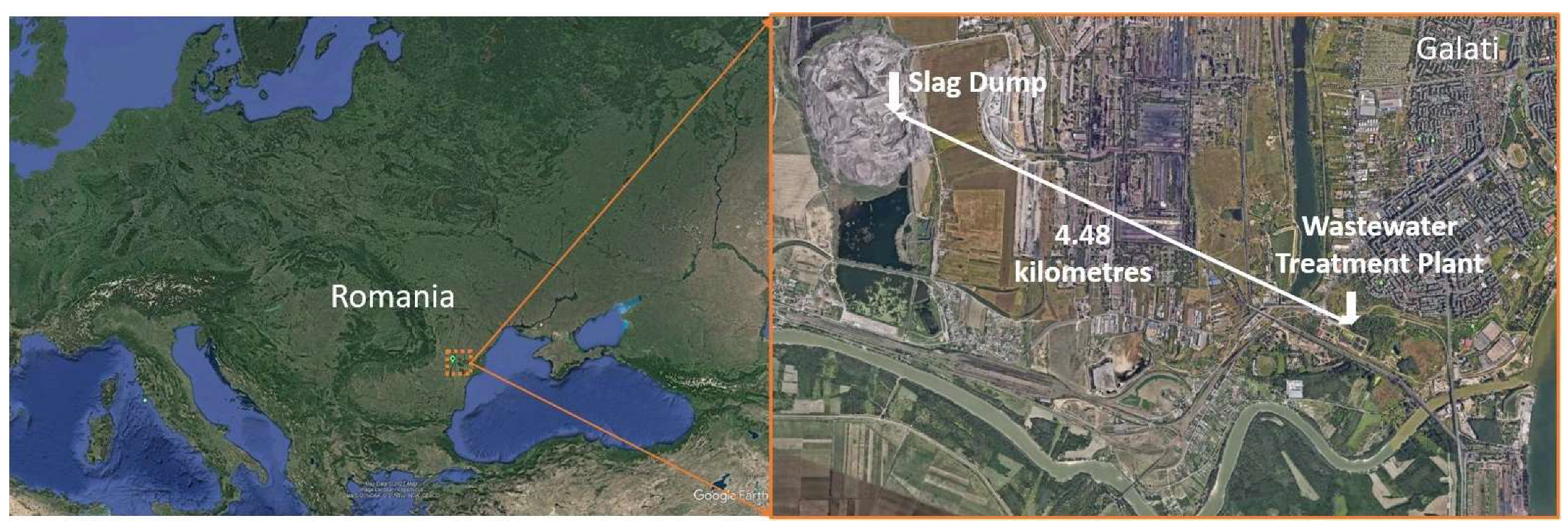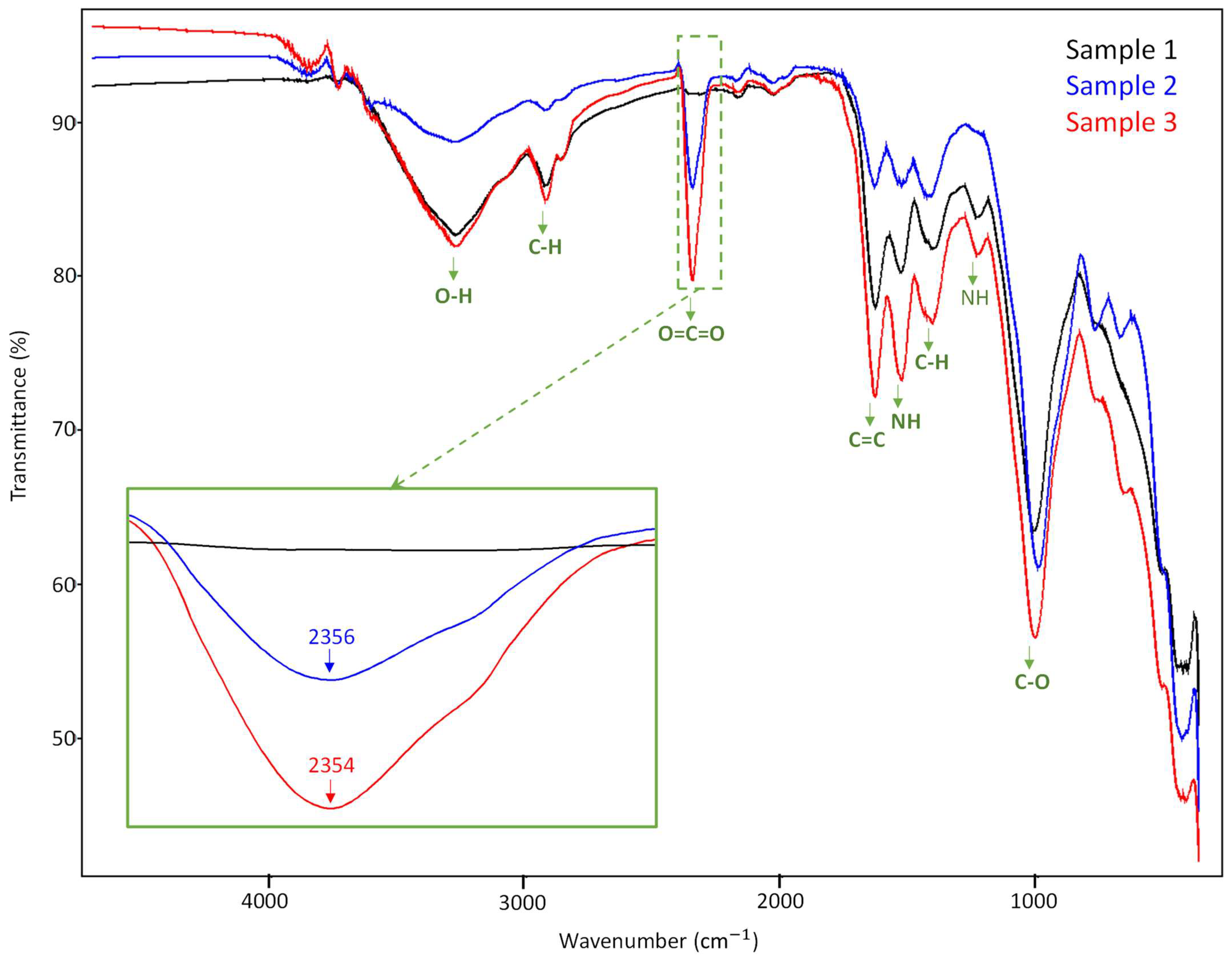A New Composite Material with Environmental Implications for Sustainable Agriculture
Abstract
:1. Introduction
2. Materials and Methods
- pastures or on fodder crops, with a minimum of three weeks before the start of grazing and harvesting of fodder crops;
- lands cultivated with vegetables and fruits during the growing season, except of fruit tree crops;
- soils intended for vegetable and fruit crops, for 10 months before harvesting and during harvesting.
2.1. Area Description and Sampling
2.2. Characterization Techniques
3. Results and Discussion
3.1. Structural and Morphological Characterization
3.2. Chemical Analysis
4. Conclusions
Supplementary Materials
Author Contributions
Funding
Institutional Review Board Statement
Informed Consent Statement
Data Availability Statement
Acknowledgments
Conflicts of Interest
References
- Lateef, A.; Nazir, R.; Jamil, N.; Alam, S.; Shah, R.; Khan, M.N.; Saleem, M.; Rehman, S. Synthesis and characterization of environmental friendly corncob biochar based nano-composite—A potential slow release nano-fertilizer for sustainable agriculture, Environmental Nanotechnology. Monit. Manag. 2019, 11, 100212. [Google Scholar] [CrossRef]
- The Urban Waste and Sewage Sludge Management Plan (2016–2020), FAOLEX No. LEX-FAOC197523. 2016. Available online: https://www.fao.org/faolex/results/details/en/c/LEX-FAOC197523/ (accessed on 22 June 2023).
- Martine, S.; Wunnewil-Flamatt, P. Thermal Runaway of the Dried Sewage Sludge in the Storage Tanks: From Molecular Origins to Technical Measures of Smouldering Fire Prevention; Impression Privee: Fribourg, Switzerland, 2007. [Google Scholar]
- Usman, K.; Khan, S.; Ghulam, S.; Khan, M.; Khan, N.; Khan, M.; Khalil, S. Sewage Sludge: An Important Biological Resource for Sustainable Agriculture and Its Environmental Implications. Am. J. Plant Sci. 2012, 3, 1708–1721. [Google Scholar] [CrossRef]
- Murariu, G.; Iticescu, C.; Murariu, A.; Rosu, B.; Munteanu, D.; Buruiana, D.L. Assessment of Water Quality State Dynamics Using Adaptive Filtering Methods and Neural Networks Approaching Case study—Danube River in Galati area. Rev. Chim. 2019, 70, 1914–1919. [Google Scholar] [CrossRef]
- Buruiana, D.; Iticescu, C.; Tiron, L.G.; Pintilie, S.; Simionescu, C.; Barnaure, M.; Balta, S. Influence of nanoparticles in membrane properties. Mat. Plast. 2015, 52, 608–611. [Google Scholar]
- Havlin, J.L.; Tisdale, S.L.; Nelson, W.L.; Beaton, J.D. Soil Fertility and Fertilizers: An Introduction to Nutrient Management; Pearson Macmillan Publishing Company: New York, NY, USA, 2021. [Google Scholar]
- Baldoni, G.; Mantovi, P.; Cortellini, L.; Re, L.D.; Toderi, G. Use of sewage sludge as a fertilizer in herbaceous plants. Inf. Agrar. 2022, 58, 31–37. [Google Scholar]
- Iticescu, C.; Georgescu, L.P.; Gurau, G.; Murarescu, M.; Dima, D.; Murariu, G.; Gheorghies, C. Methods to Reduce Environmental Impact of Municipal Waste Water Sewage Sludge. Environ. Eng. Manag. J. 2015, 14, 2457–2463. [Google Scholar]
- Iticescu, C.; Georgescu, P.-L.; Arseni, M.; Rosu, A.; Timofti, M.; Carp, G.; Cioca, L.-I. Optimal Solutions for the Use of Sewage Sludge on Agricultural Lands. Water 2021, 13, 585. [Google Scholar] [CrossRef]
- Jamil, M.; Qasim, M.; Umar, M. Utilization of sewage sludge as organic fertilizer in sustainable agriculture. J. Appl. Polym. Sci. 2006, 6, 531–535. [Google Scholar]
- Csattho, P. The Heavy Metal Pollution of the Environmental and the Agricultural Production; Tematikus Szakirodalmi Szemle, Akaprint Kiado: Budapest, Hungary, 1994; pp. 18–27. [Google Scholar]
- Tsadilas, C.D.; Masti, T.; Barbayiannis, N.; Dimoyiannis, D. Influence of Sewage Sludge Application on Soil Properties and on the Distribution and Availability of Heavy Metal Fractions. Commun. Soil Sci. Plant Anal. 1995, 26, 2603–2619. [Google Scholar] [CrossRef]
- Tester, C.F. Organic Amendment Effects on Physical and Chemical Properties of a Sandy Soil. Soil Sci. Soc. Am. J. 1990, 54, 827–831. [Google Scholar] [CrossRef]
- Wen, T.; Yang, L.; Dang, C.; Miki, T.; Bai, H.; Nagasaka, T. Effect of basic oxygen furnace slag on succession of the bacterial community and immobilization of various metal ions in acidic contaminated mine soil. J. Hazard. Mater. 2020, 388, 121784. [Google Scholar] [CrossRef] [PubMed]
- Ghisman, V.; Muresan, A.C.; Buruiana, D.L.; Axente, E.R. Waste slag benefits for correction of soil acidity. Sci. Rep. 2022, 12, 16042. [Google Scholar] [CrossRef] [PubMed]
- Reveille, V.; Mansuy, L.; Jarde, E.; Garnier-Sillam, E. Characterization of sewage sludge-derived organic matter: Lipids and humic acids. Org. Geochem. 2003, 34, 615–627. [Google Scholar] [CrossRef]
- Filip, Z.; Bielek, P. Susceptibility of humic acids from soils with various contents of metals to microbial utilisation and transformation. Biol. Fertil. Soils 2002, 36, 426–433. [Google Scholar] [CrossRef]
- Directive 86/278/EEC of 12 June 1986 on the Protection of the Environment, Especially the Soil, When Sewage Sludge is Used in Agriculture. Available online: https://eur-lex.europa.eu/LexUriServ/LexUriServ.do?uri=CELEX:31986L0278:EN:HTML (accessed on 23 July 2023).
- Obreja, C.D.; Buruiana, D.L.; Mereuta, E.; Muresan, A.; Ceoromila, A.M.; Ghisman, V.; Axente, R.E. Detection of reed using cnn method and analysis of the dry reed (Phragmites australis) for a sustainable lake area. Plant Methods 2023, 19, 61. [Google Scholar] [CrossRef] [PubMed]
- Park, S.-W.; Jang, C.-H. Characteristics of carbonized sludge for co-combustion in pulverized coal power plants. Waste Manag. 2011, 31, 523–529. [Google Scholar] [CrossRef] [PubMed]
- ORDER No. 344/708/2004 Regarding. Technical Norms regarding the Protection of the Environment and especially of Soils, when Sewage Sludge is Used in Agriculture. 2004. Available online: https://leap.unep.org/countries/ro/national-legislation/order-no-3447082004-approval-technical-rules-protection (accessed on 15 August 2023).




| Elements | Sample 1 | Sample 2 | Sample 3 | |||
|---|---|---|---|---|---|---|
| PPM | +/− 3σ | PPM | +/− 3σ | PPM | +/− 3σ | |
| Al | 10,700 | 2700 | 11,000 | 3300 | 13,900 | 4400 |
| Si | 38,800 | 1900 | 52,900 | 2700 | 72,800 | 4300 |
| P | 11,350 | 570 | 3580 | 400 | 4340 | 580 |
| S | 10,390 | 520 | 4020 | 440 | 4250 | 610 |
| K | 11,730 | 470 | 11,420 | 540 | 12,790 | 770 |
| CaO | 77,000 | 2500 | 54,900 | 2100 | 183,500 | 8400 |
| Ti | 4700 | 1000 | 3700 | 1100 | 6000 | 1800 |
| Mn | 6590 | 460 | 3140 | 340 | 8390 | 830 |
| Fe3O4 | 51,400 | 2000 | 42,500 | 1900 | 70,800 | 3900 |
| Ni | - | - | - | - | 122 | 90 |
| Cu | 333 | 60 | 185 | 53 | 101 | 69 |
| Zn | 928 | 82 | 578 | 69 | 539 | 96 |
| As | 36 | 18 | 22 | 18 | - | - |
| Rb | 52 | 11 | 69 | 12 | 61 | 18 |
| Sr | 323 | 21 | 257 | 21 | 246 | 29 |
| Y | 13 | 11 | 13 | 13 | - | - |
| Zr | 76 | 16 | 101 | 18 | 102 | 28 |
| Nb | 15 | 10 | 18 | 11 | 44 | 18 |
| Pb | 25 | 22 | 29 | 21 | 42 | 38 |
| Th | 50 | 32 | 75 | 36 | 128 | 59 |
| U | 27 | 16 | 17 | 17 | 29 | 28 |
| LE | 808,900 | 6800 | 836,600 | 6900 | 690,000 | 15,000 |
| Parameters | Recommended Values from Directive 86/278/CEE [19]. | Detected Concentrations in Sewage Sludge–Soil–Slag Sample (Sample 3) |
|---|---|---|
| Cd | 20–40 | 0.0 |
| Cu | 1.000–1.750 | 101 |
| Ni | 300–400 | 122 |
| Pb | 750–1.200 | 42 |
| Zn | 2.500–4.000 | 539 |
| Hg | 16–25 | 0.0 |
| Cr | 0.0 | 0.0 |
| Co | 0.0 | 0.0 |
| As | 0.0 | 0.0 |
| Index | Sample 1 | Sample 2 | Sample 3 | Limit Values [21] |
|---|---|---|---|---|
| Iron to Calcium Ratio (I/C) Formula: Fe2O3/CaO | 0.667 | 0.774 | 0.385 | Low: <0.31 or >3 Medium: <10.3 < I/C < 3 High: ≠1 |
| pH | 7.12 | 7.03 | 8.54 |
| Polycyclic Aromatic Hydrocarbons [mg/kg su] | Sample 1 | Sample 2 | Sample 3 |
|---|---|---|---|
| Anthracene | <0.01 | <0.01 | <0.01 |
| -Benzo [a] anthracene | <0.01 | 0.01 | 0.02 |
| Benzo [b] fluoranthene | 0.01 | 0.02 | 0.04 |
| Benzo [k] fluoranthene | <0.01 | 0.01 | 0.01 |
| Benzo [g, h, i] perylene | 0.01 | 0.02 | 0.04 |
| -Benzo [a] pyrene | 0.00 | 0.02 | 0.03 |
| -Chrysanthemum | 0.01 | 0.02 | 0.02 |
| -Fluoranthene | 0.01 | 0.03 | 0.03 |
| Indeno [1, 2, 3-cd] pyrene | 0.00 | 0.00 | 0.02 |
| -Naphthalene | 0.00 | 0.00 | 0.00 |
| -Phenanthrene | 0.02 | 0.02 | 0.00 |
| -Pyrene | 0.01 | 0.03 | 0.02 |
| Sum | 0.07 | 0.18 | 0.23 |
| Recommended values from ORDER no. 344/708/2004 [22] | 5 | 5 | 5 |
Disclaimer/Publisher’s Note: The statements, opinions and data contained in all publications are solely those of the individual author(s) and contributor(s) and not of MDPI and/or the editor(s). MDPI and/or the editor(s) disclaim responsibility for any injury to people or property resulting from any ideas, methods, instructions or products referred to in the content. |
© 2023 by the authors. Licensee MDPI, Basel, Switzerland. This article is an open access article distributed under the terms and conditions of the Creative Commons Attribution (CC BY) license (https://creativecommons.org/licenses/by/4.0/).
Share and Cite
Ghisman, V.; Georgescu, P.L.; Ghisman, G.; Buruiana, D.L. A New Composite Material with Environmental Implications for Sustainable Agriculture. Materials 2023, 16, 6440. https://doi.org/10.3390/ma16196440
Ghisman V, Georgescu PL, Ghisman G, Buruiana DL. A New Composite Material with Environmental Implications for Sustainable Agriculture. Materials. 2023; 16(19):6440. https://doi.org/10.3390/ma16196440
Chicago/Turabian StyleGhisman, Viorica, Puiu Lucian Georgescu, Georgiana Ghisman, and Daniela Laura Buruiana. 2023. "A New Composite Material with Environmental Implications for Sustainable Agriculture" Materials 16, no. 19: 6440. https://doi.org/10.3390/ma16196440






